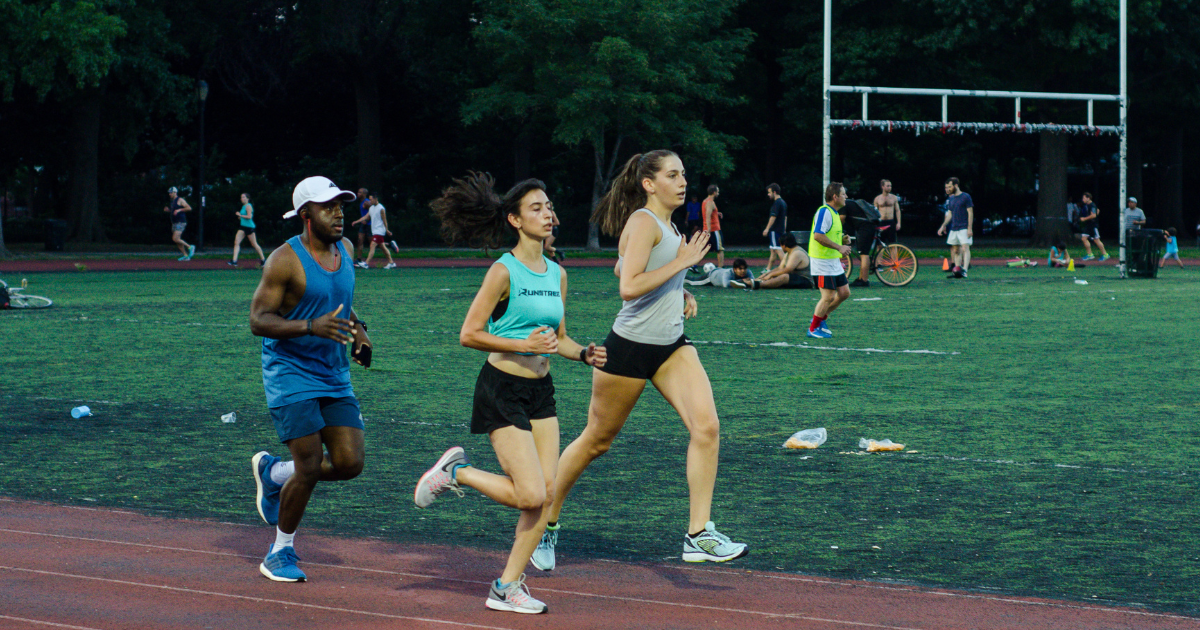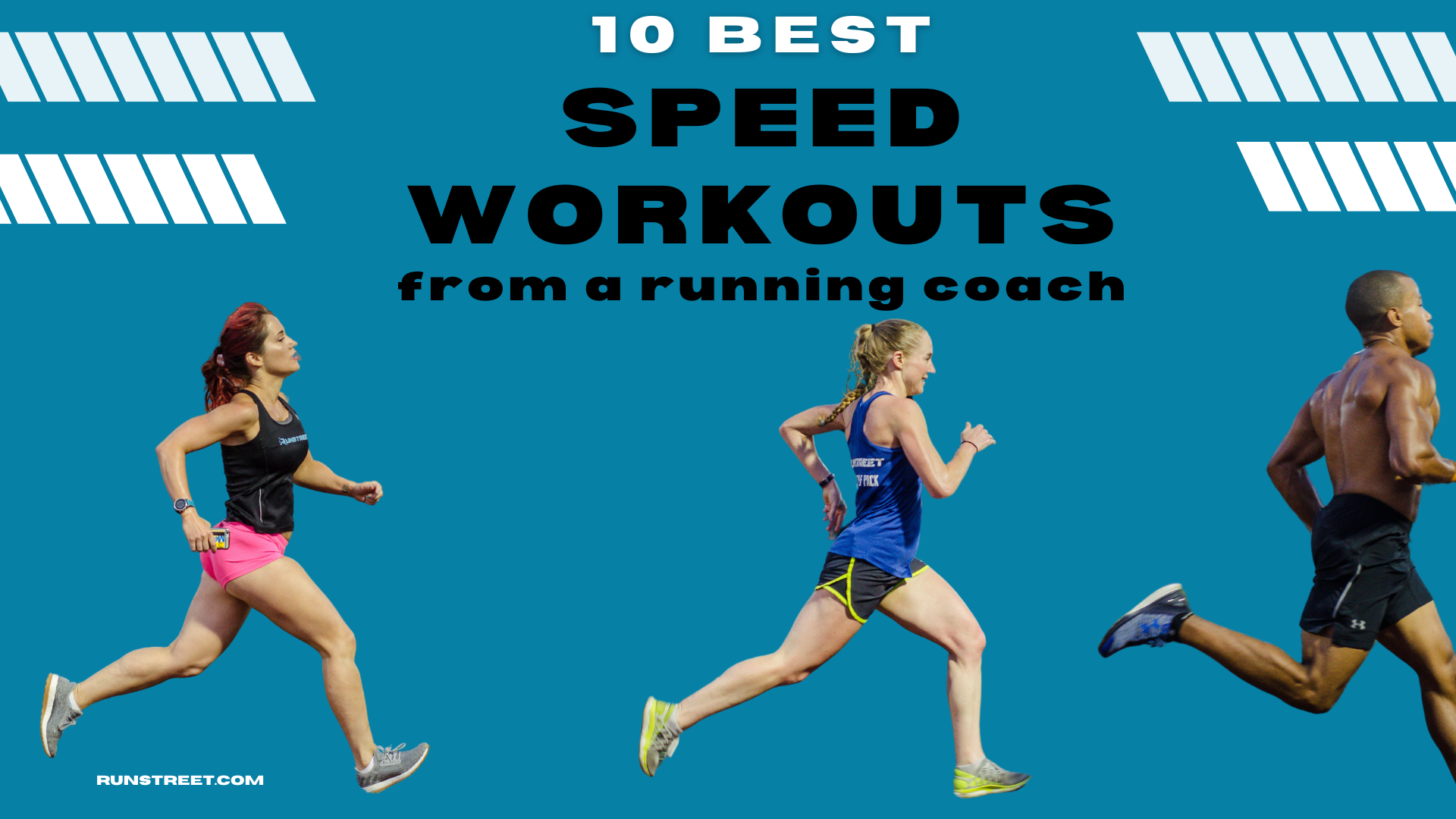5 Running Speed Workouts for 5 Different Race Distances
By Marnie Kunz,
NASM-certified personal trainer, USATF- RRCA-certified run coach
Whether you’re running the NYC Half Marathon, a local 5K race, or the Chicago Marathon, running speed workouts will help you slay your race goals and make you faster. It’s important to do speed workouts that suit your goal race distance. As a running coach, I have come to rely on some staple speed workouts to help people at different stages of running. I’m sharing my key speed workouts for each race distance here and offering a breakdown of how to do each running workout. These speed workouts are for the most popular race distances - the mile, 5K, 10K, half marathon, and marathon. If you need customized running speed workouts or a training plan, check out the Runstreet Training Center.
These running speed workouts can be adapted to all fitness levels. If you are a new runner, make sure you do 6 weeks of base runs (slow, relaxed pace runs) to build up your fitness base before adding speed training to your running routine.
What Is A Running Speed Workout?
Speed workouts are designed to push you to run faster than your average relaxed run pace. Your running speed workouts may be in the form of intervals – short bursts of faster running with periods of recovery in between them – or they may be steady effort runs at a faster pace than your regular base run pace.
While intervals involve short bursts of speed, tempo runs include steady-state effort runs at a faster pase than your usual relaxed running workouts. Both types of speed workouts can help you run faster and crush your running goals.
You know those times when you go out and run your usual routes at your relaxed running pace? Well, those are not speed workouts. Speed workouts step up your pace and are more high intensity to help you become a stronger runner and experience less fatigue in races. The easy days are still important too for endurance and fitness, but running speed workouts are the key to becoming faster.
Benefits of Speed Training
Speed workouts challenge your body to deliver oxygen to your muscles even when you’re fatigued, and they improve your body’s oxygen efficiency. These intense workouts also strengthen your legs and boost your mental toughness. You’ll gain confidence as a runner and athlete as you tackle the challenge of speed workouts. Here are some of the main benefits of running speed workouts:
Makes you faster. You will be able to run faster in races when you do regular speed workouts.
Improves muscle definition. According to the American Council on Exercise, speed workouts improve your leg strength and muscle definition, making you more fit and strong.
Has anti-aging benefits. Speed workouts boost your type II muscle fibers, which deteriorate with age. Speed work helps build your lean muscle tissue, which also helps your metabolism run more efficiently, and you will burn more calories even while at rest.
Common track workout distances include 200, 400, and 800 meters.
How Often to Do Speed Workouts
If you are just getting back into running or if you’re a beginner, start with running one to two speed workouts a week. Make sure you follow the easy-hard principle of training and schedule a rest day or easy run the day after a speed workout. You don’t want to do two speed workouts in a row as your body needs time to recover.
For advanced runners, you can run two to three speed workouts a week. Most runners find that two speed workouts a week offer maximum performance benefits while allowing enough recovery time. One or two speed workouts a week also give you time to do a weekly long run if you’re training for long-distance races such as the marathon.
Mile Speed Workout
Short intervals will help you run a faster mile.
If you’re training for a mile race, then congratulations, you get to do short intervals for your running speed workouts! Short doesn’t mean they will be easy though, as you will be cruising along at a fast pace. Here is a great interval workout to improve your speed for a mile race:
200-Meter Intervals Workout
Warm-Up: Run 10 minutes to warm up at a relaxed, easy pace. Do dynamic stretches.
Run 200 meters at your goal mile pace.
Run 200 meters at a relaxed pace for recovery.
Repeat to run a total of 4 fast intervals and 4 slow.
Cool Down: Run 10 minutes slowly to cool down. Stretch.
You can build intensity and speed endurance with this workout by adding an additional fast interval every two weeks until you can do a maximum of eight 200-meter fast intervals and eight slow recovery laps. Aim for consistency with your pace. You do not want to start too fast and get slower but instead, maintain the same pace for each fast interval. If you cannot run at your mile goal pace for 200 meters, you may need to adjust your goal pace or gradually increase your speed over a period of weeks until you can run the 200-meter intervals at your mile race pace.
400-meter intervals will improve your speed.
5K Speed Workout
The 5K race is the most popular race distance and offers a fun and challenging mix of speed and endurance over a period of 3.1 miles or 5 kilometers. This 400-meter interval workout is one of my favorite running speed workouts to improve leg speed and 5k race pace. You can do these 400-meter intervals by running one lap on a standard outdoor track, which equals 400 meters, or run for .25 of a mile if you’re using a GPS device and running on sidewalks or trails.
400-Meter Intervals Workout
Warm-Up: Run 10 minutes to warm up at a relaxed, easy jog pace. Do dynamic stretches.
Run 400 meters at 30 seconds faster than your goal 5K pace. (So if your goal 5K pace is a 9-minute mile pace, for instance, run your intervals at an 8:30-minute mile pace).
Run 400 meters at a relaxed pace for recovery.
Repeat to run a total of 5 fast intervals and 5 slow.
Cool Down: Run 10 minutes slowly to cooldown. Stretch.
As with the mile speed workout, you want to aim for consistent times on your 400-meter intervals. You may feel like you are not going very fast the first 400 meters, but by the end, you will be glad you didn’t start too fast. As you build endurance, you can add more intervals to this speed workout. Every 2 weeks add another fast 400-meter interval until you reach a maximum of ten 400-meter speed intervals.
Try this speed workout for 10K training.
10K Speed Workout
A 10K race (6.2 miles) is a great challenge for those who want to step up the distance from 5K races. For great 10K running speed workouts, try these 800-meter intervals. Running 800s is a great workout for improving your endurance for long races like the 10K, half marathon, and marathon. Check out our Yasso 800s post to learn how 800s can help with your marathon training.
800-Meter Intervals Workout
Warm-Up: Run 10 minutes to warm up at a relaxed, easy pace. Do dynamic stretches.
Run 800 meters at your goal 5K pace.
Run 800 meters at a relaxed pace for recovery.
Repeat to run a total of 4 fast intervals and 4 recovery intervals.
Cool Down: Run 10 minutes slowly to cool down. Stretch.
As with the other interval workouts, you can build up your endurance by adding more intervals to this speed workout over time. For an easy-to-measure 800-workout, go to your local track, where a standard length lap equals 400 meters, so two laps equal an 800-meter interval.
Half Marathon Speed Workout
The half marathon is a distance that requires you to start adding weekly long runs to your training. The tempo run is a great running speed workout for half marathon training. Tempo runs boost your lactate threshold and improve your half marathon pace. Lactate threshold is the point at which lactate accumulates in your blood faster than it can be removed, making your body feel fatigued. Tempo runs will boost your lactate threshold so you can sustain hard efforts for longer, which will definitely help your race performance. Check out our Tempo Run Guide for a full rundown on the tempo run.
Tempo intervals offer a less intimidating workout than regular tempo runs and help ease you into tempo runs.
Tempo Intervals Workout
Warm-Up: Run 10 minutes to warm up at a relaxed, easy pace. Do dynamic stretches.
Run for 7 minutes at your 10K race pace. This should feel like a 70% to 80% effort level, challenging but you’re able to breathe and maintain your pace.
Run for 2 minutes at a relaxed pace for recovery.
Repeat to run a total of 3 fast intervals and 3 recovery intervals.
Cool Down: Run 10 minutes slowly to cool down. Stretch.
Marathon Speed Workout
If you are training for the marathon, the mother of all distance races, then a tempo run will help you improve your race pace and endurance. In contrast with the other running speed workouts I’ve listed here, the tempo run is a steady state effort that you maintain for a longer period. For tempo runs, you want to run at a pace that you could maintain for an hour, which is about your 10K race pace.
For more tempo run tips, check out this post.
Tempo Run Workout
Warm Up: Run 10 minutes to warm up at a relaxed, easy pace. Do dynamic stretches.
Run for 20 minutes at your 10K race pace. This should feel like a 70 to 80% effort level, challenging but you’re able to breathe and maintain your pace.
Cool Down: Run 10 minutes slowly to cool down. Stretch.
Each week, add a few minutes to your tempo run until you are running a maximum of an hour at your tempo pace. The tempo run will be your greatest weapon to crush your marathon PR goals, in addition to your weekly long runs.
Strength Training
In addition to doing some speed workouts, strength training will help you become a stronger, faster runner. You can start with bodyweight exercises like squats, lunges, push-ups, and planks. I recommend strength training at least twice a week to improve your running economy and running form.
Related: Strength Training Guide for Runners
Have you tried any of these running speed workouts? Let me know which workouts have helped you most in the comments below or tag @Runstreet on Instagram to share your workouts and get cheered on. If you need a customized running plan with speed workouts, check out my plans in the Runstreet Training Center.
Happy – and speedy – running to you, Wolf Pack!😊
Related Posts: How to Do a Fartleks Workout, How to Run Yasso 800s, Tempo Run Guide, 10 Long Run Tips from a Run Coach, Marathon Training Guide for All Levels
Marnie Kunz is a NASM-certified personal trainer and USATF- and RRCA-certified running coach based in Brooklyn, NY. Marnie likes helping people get and stay active to enjoy a better quality of life. When she’s not doing fitness things, Marnie enjoys exploring with her dog, a mischievous rescue Akita.






